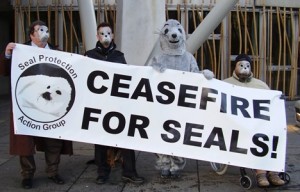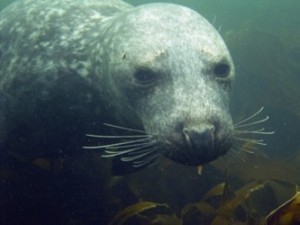The Seal Protection Action Group has welcomed a continuing downward trend in seal shooting under government licence in Scottish waters, but warned that the mass seal killings continue to damage Scotland’s reputation and much more must be done to end the practice.
The latest figures, just posted on a Scottish Government website www.gov.scot/Topics/marine/Licensing/SealLicensing, reveal that a total of 161 grey and 41 common seals were reported shot in 2014, or 205 animals in total.
With 238 grey and 36 common seals, 274 in total, shot in 2013, this represents 69 fewer seals than were reported shot in 2013 (274) and 254 fewer than in 2011 (459).
This means the number of seals reported shot has fallen by 55% in the four years since the Seal Licence scheme was introduced in 2011. 
The Seal Licence was introduced in January 2011 to regulate seal killings. It is now illegal to kill a seal without one. Even so, a staggering 1,1373 seals have been reported shot in four years under the seal licence scheme, an average of 343 seals each year, or one seal shot nearly every single day.
The Scottish Government website also reveals that 51 licences have been issued to shoot a maximum of 662 grey and 197 common seals, or 859 seals in total, during 2015. The seals will be shot at fish-farms, allegedly to protect salmon stock and equipment, and in rivers by salmon netting companies and the sports angling industry.
In 2013, 105 seals were shot by fish-farmers and 169 were shot by wild salmon netting companies and sports-angling interests.
Of the 205 seals shot in 2014, 80 seals or 39% were shot by fish-farmers and 125 seals or 61% by wild salmon netting companies and sports-angling interests.
According to these figures around 75% of seals shot by aquaculture are shot at RSPCA-accredited Freedom Food Farms.
The Seal Protection Action Group is working to end all seal shooting. In 2010, we founded the www.saswg.org.uk to investigate and promote benign alternatives such as better practice, properly tensioned nets and new acoustic scaring devices that do not harm seals or other marine life such as porpoises.
However, while some aquaculture companies, such as Marine Harvest, have all but eliminated seal shooting others have not, and wild salmon netting companies and river fisheries are now shooting most seals.
Seals are still being shot even though trials of a new acoustic seal deterrent device, developed by the Seal Mammal Research Unit (SMRU) at St Andrews University with a grant from the Scottish government, have suggested it could be very effective at deterring seals from fish-farms, salmon nets and sports-angling rivers without harming them or other wildlife. SPAG has condemned as ‘scandalous’ the fact that a device developed with public funds has been ‘sold’ to a private finance company in America and is yet to be made widely available to the industry.
“I don’t think that people buying Scottish salmon or visiting Scotland for a fly-fishing holiday realize the terrible price that our seals are paying for their pleasure” said Andy Ottaway of the SPAG, “SPAG is calling on the Scottish government and salmon industry to pull together and end seal shooting which leaves a bloody stain on the image of Scotland and Scottish salmon products.
Notes:
•The expansion of salmon production may have serious consequences for wildlife and tourism says SPAG. In 2012, an English couple cut short a holiday in Aberdeenshire after witnessing seals being shot in a bay at Crovie, Aberdeenshire. Around 30 seals were shot by the Usan Salmon Fisheries Company. Marine Scotland said the company ‘had not exceeded the terms of their licence’.
•A new Acoustic Deterrent Device, developed by SMRU scientists at St Andrew’s University with government funding is now owned by Bankers Capital of New York
•A forum, the Salmon Aquaculture and Seals Working Group, was established in 2010 to explore non-lethal solutions to deter seals. Members are the Seal Protection Action Group; Marine Harvest; Scottish Salmon Company, Scottish Salmon Producers Organisation, Sainsbury’s; International Animal Rescue; the RSPCA, Freedom Foods, Humane Society International, Marine Scotland, Scottish Natural Heritage and the Sea Mammal Research Unit (SMRU)
•Scientists report a ‘frightening’ decline in common seals www.smru.st-andrews.ac.uk/documents/scos_2008_v1.pdf
•The UK’s globally important populations of grey and common seals are threatened by climate change, toxic pollution, over-fishing, entanglement in fishing gear,disturbance, habitat degradation and deliberate killing.
•SPAG is calling on UK retailers to insist Scottish salmon suppliers stop killing seals.
•SPAG opposes the Seal Licence because it permits shooting of seals in the breeding seasons leaving abandoned pups to starve; lacks a credible inspection and monitoring scheme, sets quotas for common seals that are in serious decline and grey seals, that number fewer than African elephants, and fails to impose mandatory non-lethal deterrents to reduce and ultimately end all seal killings.


 which could see Scottish salmon imports banned within the next two years unless seal killings are stopped completely. The new laws require all US trading partners to prohibit the deliberate killing or serious injury of marine mammals in all fisheries, including aquaculture, or face a complete ban on access to US markets. With Scottish exports of salmon worth £600 million in 2017, the US represents the single biggest export market for the sector at almost £200 million in 2017.
which could see Scottish salmon imports banned within the next two years unless seal killings are stopped completely. The new laws require all US trading partners to prohibit the deliberate killing or serious injury of marine mammals in all fisheries, including aquaculture, or face a complete ban on access to US markets. With Scottish exports of salmon worth £600 million in 2017, the US represents the single biggest export market for the sector at almost £200 million in 2017.











